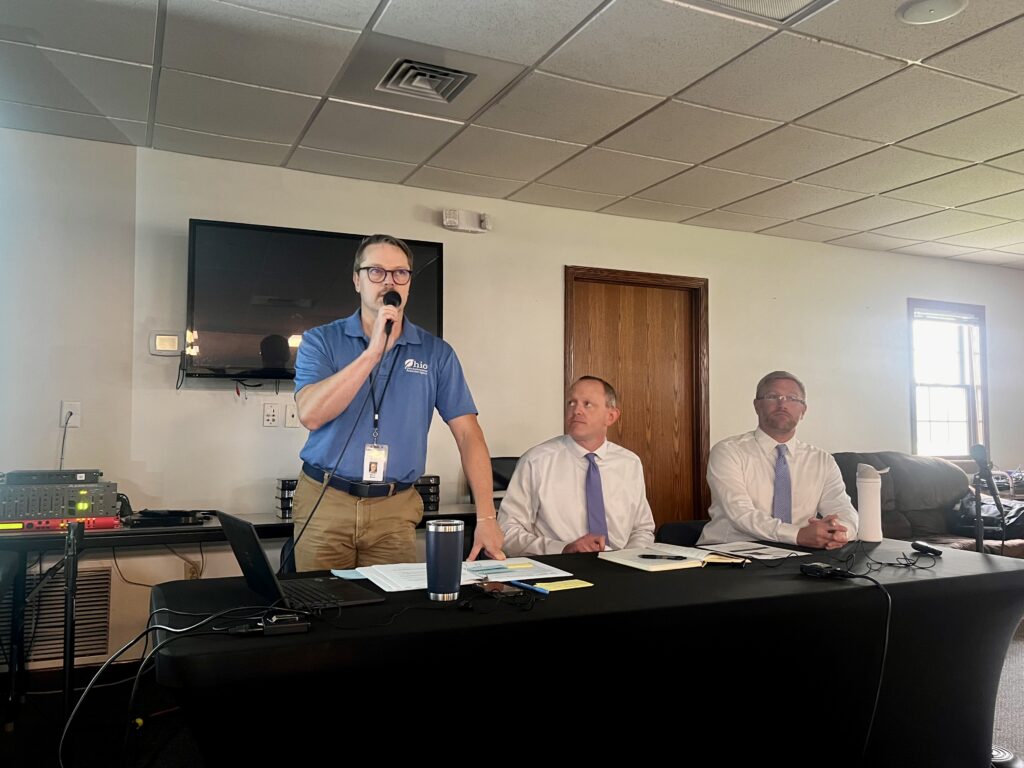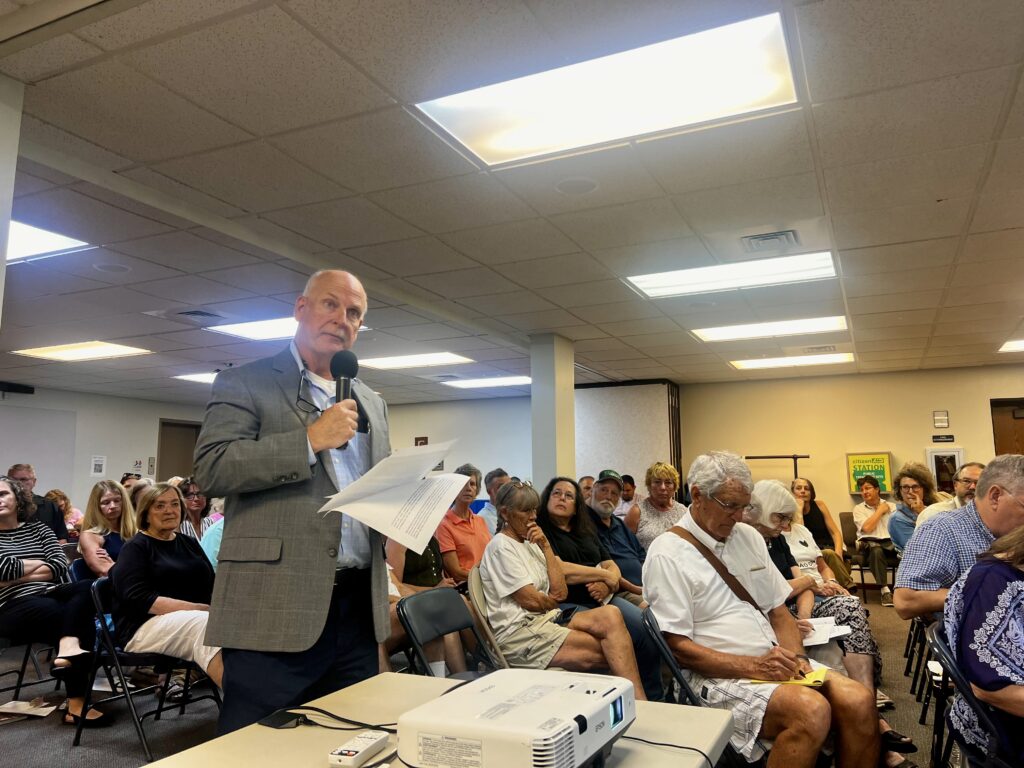“Rushed” is the word that Sean Barnes, mayor of the Village of Alexandria in Licking County, would use to describe development coming to the area due to Intel’s construction of a $28 billion computer-chip factory west of the village.
Some of that development, including a proposal for a wastewater treatment plant that would be operated by Southwest Licking Community Water and Sewer District near the Moots Run stream, has residents concerned.
More than 200 people packed into the Church of Christ at Alexandria’s basement for an Ohio Environmental Protection Agency hearing over the proposed wastewater treatment plant on July 17, when Barnes voiced his concerns.
“We all know when things are rushed we’re more likely to make poor decisions or do incomplete work,” Barnes said in his testimony at the hearing.
The hearing, set by the Ohio EPA to review a National Pollutant Discharge Elimination System (NPDES) permit for the wastewater treatment plant, included an informal presentation, a question-and-answer session and the hearing with public testimony.
David Brumbaugh, from the Ohio EPA division of surface water, gave a presentation about the NPDES permit being sought by SWLCWSD.

The potential wastewater treatment plant would discharge into Moots Run, which feeds Raccoon Creek, which recharges the well field from which Granville draws drinking water for both Granville and Alexandria residents. The plant, designed to serve Jersey Township between New Albany and Alexandria, would discharge up to 3 million gallons of treated water per day into the creek, meaning the Ohio EPA would classify the plant as a “major facility.”
Antidegradation rules say the Ohio EPA is responsible for protecting and maintaining existing uses for the streams in the state. The rules require the Ohio EPA to review applications when new or more pollutants are being added to a stream.
Southwest Licking said the socioeconomic reasoning for a new wastewater plant is industrial growth coming to the New Albany Industrial Park area of western Licking County. The application said the socioeconomic benefits that would be lost are farmland and sewer rate increases.
Margaret Toland, a resident of St. Albans Township, said that economics is based on the quality of life, and lost farmland and a high sewer rate are an abysmal representation of the benefits that will be lost because of the plant.
“Just tonight, in my chicken scratch here, I noted close to 100 benefits lost,” Toland said during her testimony.
Many residents and public officials asked the EPA to wait until studies like the water-quality management plan and a 15-county water study currently underway are completed, and additional studies should be done before a decision is made.
Kristy Hawthorne, Program Administrator for Licking County Soil and Water District, requested that baseline testing be done so it can be determined if the water in Moots Run is polluted by the wastewater treatment plant.
“Our motto is that every acre counts for soil health, and every drop counts for water quality. Therefore, every parcel of land developed and every permit the Ohio EPA reviews counts,” Hawthorne said.
Bryn Bird, a Granville Township Trustee, is concerned about flooding that could come with this wastewater treatment plant. She reminded everyone that the TJ Evans Bike Trail had flooded just east of Granville and wiped out a popular section of the path that has since been closed down. Bird asked that all degradation planning and additional studies be exhausted before this permit is approved.
Several mayors, trustees, and city managers from the area attended the hearing and gave testimony opposing the wastewater treatment plant.
“Ask yourselves tonight why so many jurisdictions are here tonight and why so many people oppose this utility provider if these plans are solid and it won’t hurt the environment and it’s good for this area,” Melissa Hartfield, the Mayor of Granville, said during her testimony.
Barnes said when he stepped into the role as Mayor of Alexandria, he was asked to attend meetings about water and sewer plans. The Mid-Ohio Regional Planning Commission (MORPC) and the Ohio EPA tasked Johnstown, Alexandria, and Granville (JAG) to meet with SWLCWSD to plan for future service areas within the boundaries of the water-quality management plan for Licking County, known as a “208 Plan.”
“We were told that the reason everyone wanted us to work together on this plan was that there was a desire for, and I quote, ‘local solutions to local problems,” said Barnes.
Barnes said that they had met over the course of six months and the process was well underway. JAG leaders were close to completing a service-area map that would be presented to the Ohio EPA and MORPC when they learned about the SWLCWSD request for the permit to operate a sewage-treatment plant in the area.
Sean Staneart, the Johnstown City Manager, said that working with JAG has taught him that the problems communities are facing are too big to handle on their own.
“To solve these large issues, we must collaborate with our neighbors,” Staneart said. “I am confident that we can find a solution that empowers intentional growth.”
Barnes asked the Ohio EPA to wait until St. Albans Township and Alexandria voters have had a chance to vote in November 2025 on a proposed merger of the two entities. According to Barnes, if the merger passes, the new village will become the designated management agency for water and sewer for the entire incorporated area from which the SWLCWSD plant would be providing services to other jurisdictions, which would complicate things for all parties involved.
“Let us decide the question of the merger at the ballot box before making a decision that could have lasting impacts on our community,” Barnes said.

Jim Roberts, executive director of Southwest Licking Community Water and Sewer District, spoke in favor of the wastewater treatment plant, saying that water discharged from the plant will meet all required tests for the safety and well-being of the communities.
“We do not control development,” he said. “Rather, we respond to the needs of our community as determined by local governments and their zoning regulations.”
Roberts said that the district’s existing facilities have excellent compliance records that demonstrate how South West Licking protects the environment and provides reliable services.
“I would like to invite anyone with concerns to tour our existing facilities and learn more about our high-quality systems,” Roberts said.
Sandra Doty, a Granville resident and physics professor at Denison University, helped the audience understand what 3 million gallons of water a day would look like in Moots Run, given that a quantity that large might be hard to imagine.
“Three million gallons per day is 125,000 gallons an hour,” she said. “That’s 2,083 and a third gallons a minute. That’s 35 gallons a second.”
Doty said this is a concern, because Moots Run has high variability. For example, right now, it is pretty dry, but in April it was flooded. She said she has not found any studies or data about the flow rates of Moots Run, and she does not think it was considered in the SWLCWSD application.
“If my students turned in a lab report that had that little background to substantiate their statement that there will be no environmental impact, they would fail,” Doty said.
Granville Mayor Hartfield pointed out that the application mistakenly cited a conservation group for a Raccoon Creek in Athens County instead of Licking County.
“They didn’t even take the time to look to see that it’s not even local,” Hartfied said. “That’s what this whole application is filled with.”
Caroline Zollinger writes for TheReportingProject.org, the nonprofit news organization of Denison University’s Journalism program, which is supported by generous donations from readers. Sign up for The Reporting Project newsletter here.

